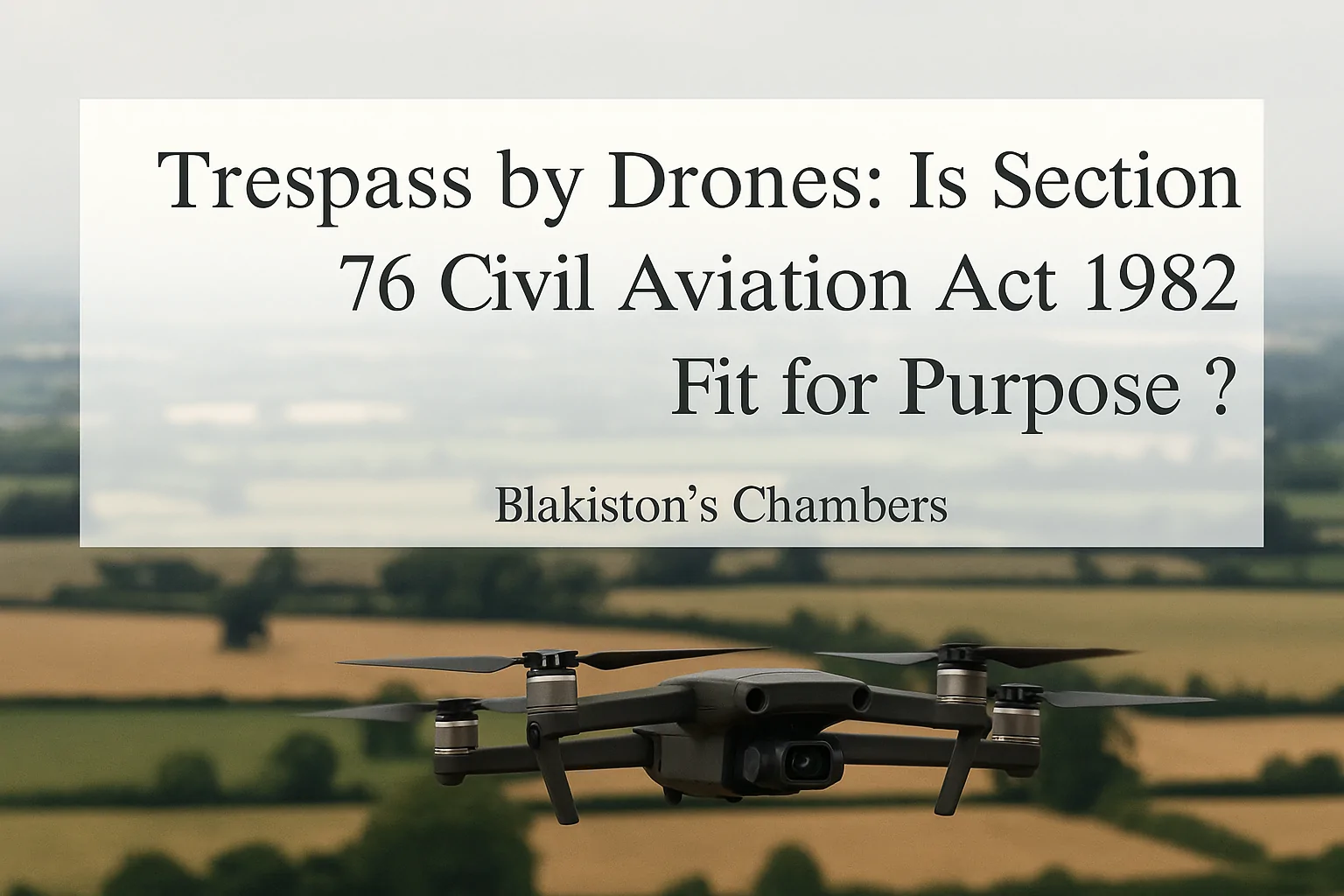Why this matters for drone companies
The question of whether a drone operator can be sued for trespass when flying over private land is no longer a theoretical debate. With drones now routinely used for surveying, deliveries, inspections, and filming, landowners are increasingly asking whether they can stop flights above their property.
At the heart of this issue lies section 76 of the Civil Aviation Act 1982. Originally drafted for manned aviation, it has never been fully adapted to the realities of drones flying close to the ground, often well below 400 feet.
Recent High Court cases – Anglo-International Upholland Ltd v Wainwright (2023) and MBR Acres Ltd v Curtin (2025) – have thrown the law into sharper focus. For drone operators, the practical question is whether your drone can legally enter the airspace above a neighbour’s land without risking an injunction or damages claim.
Trespass: the basic position
Trespass is normally straightforward: step onto someone’s land without permission, and you’re liable – even if you cause no harm. Landowners don’t need to prove loss; mere entry is enough.
But what about airspace? Does a landowner “own the sky” above their property? Historically, English law used the maxim cujus est solum, ejus est usque ad coelum – whoever owns the soil owns all the way up to the heavens. Courts have long since rejected that absolute view. Instead, the law recognises ownership only of the airspace “necessary for the reasonable enjoyment of the land”.
For manned aircraft, Parliament drew a compromise in section 76(1): flights at a “reasonable height” cannot be challenged as trespass or nuisance. But what is a “reasonable height” when drones are often flown at 50 metres, 20 metres, or even lower?
Bernstein and the buffer zone
In Bernstein v Skyviews (1978), a landowner sued after an aircraft flew hundreds of feet above his estate to take photographs. The court held that this was not trespass, because the aircraft was too high to interfere with the landowner’s use of his land.
That decision gave us a rough principle: landowners control only the slice of airspace that matters to their ordinary use of land. The problem is that drones now operate in precisely that slice – near buildings, gardens, roads, and industrial sites – where interference with land use is most likely.
The new drone cases
1. Anglo-International (2023)
Drone flights over a derelict college were used to capture images which encouraged trespassers to enter the site. The judge treated the flights as mischievous and granted an injunction, holding that section 76 did not protect the operators.
The ruling was short and did not carefully analyse airspace ownership or flight height, but it showed courts are willing to act against drone flights if their purpose is seen as facilitating trespass or mischief.
2. MBR Acres (2025)
Animal rights campaigners used drones to film over a research facility. Some drones were flown as low as the height of a single-storey building, but evidence on height and operators was inconsistent.
The judge refused to grant an injunction. He accepted that flights at 50 metres or more did not interfere with the use of the land. Importantly, he suggested that other legal remedies – nuisance, harassment, or data protection – might be more appropriate than trespass.
What this means for drone operators
- Trespass claims are harder to make stick than many landowners think. Courts are reluctant to find trespass unless flights interfere with the actual use of land (e.g. disrupting activity on site, flying extremely low, or endangering people).
- Section 76 may be becoming redundant. Both Bernstein and MBR Acres suggest that unless a flight interferes with land use, there is no trespass at all – making section 76’s “reasonable height” defence almost irrelevant.
- Purpose of flight matters – at least sometimes. In Anglo-International, mischievous use of drones was enough to justify an injunction. Operators engaged in legitimate commercial activity (surveying, deliveries, inspections) are on stronger ground.
- Evidence is critical. Landowners will struggle to obtain injunctions unless they can prove height, frequency, and impact of flights. For operators, maintaining robust flight logs and compliance records (as required by the UK drone regulations) is the best defence.
- Regulatory compliance is non-negotiable. Section 76 only protects operators if flights are lawful. Breach of drone regulations (flying beyond visual line of sight, too close to people, or over congested areas without permissions) will undermine any defence.
Looking ahead
The law remains unsettled. Drone operators should assume:
- Routine overflights at safe, documented altitudes are unlikely to amount to trespass, provided they don’t interfere with land use.
- Low-level flights directly over private land remain risky, particularly if they appear intrusive, harassing, or unsafe.
- Other causes of action are emerging – nuisance, data protection, and harassment are likely to be more powerful tools for landowners than trespass.
For commercial operators, the key is to plan flight paths with landowner sensitivities in mind, document compliance, and keep up with evolving case law. What remains unclear is whether Parliament will modernise section 76 to deal explicitly with drones – or whether the courts will continue to adapt 20th-century law to 21st-century technology.
Blakiston’s Chambers advises drone operators, manufacturers, and service providers on all aspects of UK drone law, including airspace rights, regulatory compliance, and litigation risk. If your business is concerned about trespass or overflight liability, our team can help.

